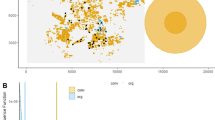Abstract
Empirical studies have revealed scaled structure on a variety of landscapes. Understanding processes that produce these structures requires neutral models with hierarchical structure. The present study presents a method for generating random maps possessing a variety of hierarchical structures. The properties of these scaled landscapes are analyzed and compared to patterns on totally random, unstructured landscapes. Hierar-chical structure permits percolation (i.e., continous habitat spanning the landscape) under a greater variety of conditions than found on totally random landscapes. Habitat clusters on structured maps tend to have smaller perimeters. The clusters tend to be less clumped on sparsely occupied landscapes and more clumped in densely occupied conditions. Hierarchical structure changes the expected spatial properties of the landscape, indicating a strong need for this new generation of neutral models.
Similar content being viewed by others
References
Anderson, D.J. 1971. Spatial patterns in some Australian Dryland plant communities. pp. 271–286.In G.P. Patil and W.E. Waters (eds.) Statistical Ecology, Volume 1. Spatial Patterns and Statistical Distributions. Pennsylvania State University Press, University Park, PA.
Barnsley, M.F., Ervin, V., Hardin, D. and Lancaster, I. 1986. Solution of an inverse problem for fractals and other sets. Proc. Natl. Acad. Sci. 83: 1975–1977.
Caswell, H. 1976. Community structure: a neutral model analysis. Ecol. Monogr. 46: 327–354.
Forman, R.T.T. and Godron, M. 1986. Landscape Ecology. John Wiley and Sons, NY.
Gardner, R.H., Milne, B.T., Turner, M.G. and O’Neill, R.V. 1987. Neutral models for the analysis of broad-scale landscape pattern. Landscape Ecology 1: 19–28.
Gardner, R.H., O’Neill, R.V., Turner, M.G. and Dale, V.H. 1989. Quantifying scale-dependent effects of animal movement with simple percolation models. Landscape Ecology 3: 217–227.
Gefen, Y, Aharony, A. and Alexander, S. 1983. Anomalous diffusion on percolating clusters. Physical Review Letter 50: 77–80.
Greig-Smith, P. 1983. Quantitative Plant Ecology. University of California Press, Berkeley, CA.
Krummel, J.R., Gardner, R.H., Sugihara, G. and O’Neill, R.V. 1987. Landscape patterns in a disturbed environment. Oikos 48: 321–324.
Lavorel, S., Gardner, R.H. and O’Neill, R.V.A. model for the analysis of patterns in structured landscapes (manuscript).
Levin, S.A. and Buttel, L. 1987. Mesures of patchiness in ecological systems. Publication No. ERC-130, Ecosystem Research Center, Cornell University, Ithaca, NY.
Mandelbrot, B. 1983. The Fractal Geometry of Nature. W.H. Freeman and Co., NY.
O’Neill, R.V., Milne, B.T., Turner, M.G. and Gardner, R.H. 1988. Resource utilization scales and landscape pattern. Landscape Ecology 2: 63–69.
O’Neill, R.V., Johnson, A.R. and King, A.W. 1989. A hierar-chical framework for the analysis of scale. Landscape Ecology 3: 193–206.
O’Neill, R.V., Gardner, R.H., Milne, B.T., Turner, M.G. and Jackson, B. 1991a. Heterogeneity and spatial hierarchies. pp. 85–96.In J. Kolasa and Pickett, S.T.A. (eds.) Ecological Heterogeneity. Springer-Verlag, NY.
O’Neill, R.V., Turner, S.J., Cullinen, V.I., Coffin, D.P., Cook, T., Conley, W., Brunt, J., Thomas, J.M., Conley, M.R. and Gosz, J. 1991b. Multiple landscape scales: An intersite comparison. Landscape Ecology 5: 137–144.
Orbach, R. 1986. Dynamics of fractal networks. Science 231: 814–819.
Stauffer, D. 1985. Introduction to Percolation Theory. Taylor and Francis, London.
Turner, M.G. 1989. Landscape Ecology: The effect of pattern on process. Annu. Rev. Ecol. Syst. 20: 171–197.
Turner, M.G., Gardner, R.H., Dale, V.H. and O’Neill, R.V. 1989. Predicting the spread of disturbance across heterogeneous landscapes. Oikos 55: 121–129.
Urban, D.L., O’Neill, R.V. and Shugart, H.H. 1987. Landscape ecology. Bioscience 37: 119–127.
Watt, A.S. 1947. Pattern and process in the plant community. J. Ecol. 35: 1–22.
Author information
Authors and Affiliations
Additional information
Research supported by the Ecological Research Division, Office to Health and Environmental Research, U.S. Department of Energy under contract No. DE-AC05-840R21400 with Martin Marietta, Energy Systems, Inc. Environmental Sciences Publication No. 3813, ORNL.
Rights and permissions
About this article
Cite this article
O’Neill, R.V., Gardner, R.H. & Turner, M.G. A hierarchical neutral model for landscape analysis. Landscape Ecol 7, 55–61 (1992). https://doi.org/10.1007/BF02573957
Issue Date:
DOI: https://doi.org/10.1007/BF02573957




